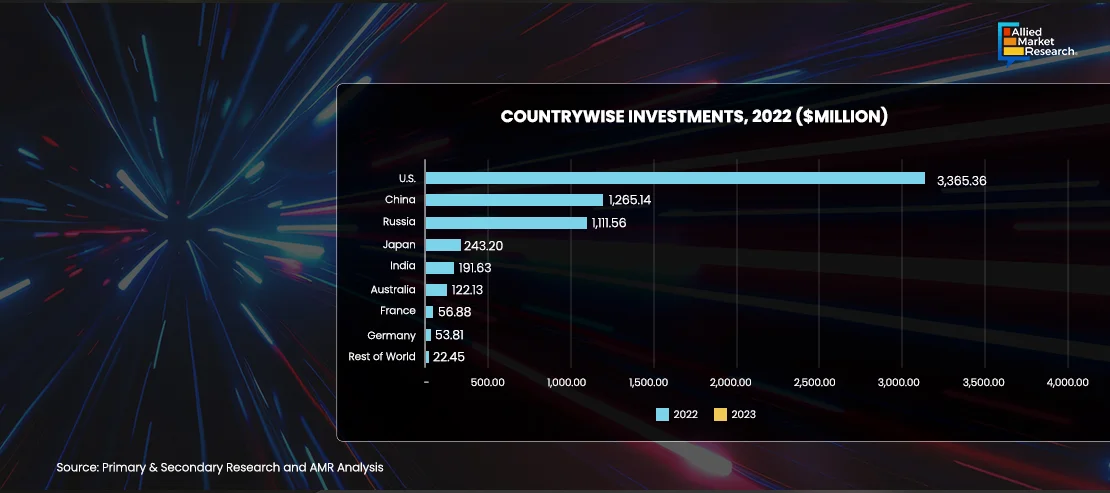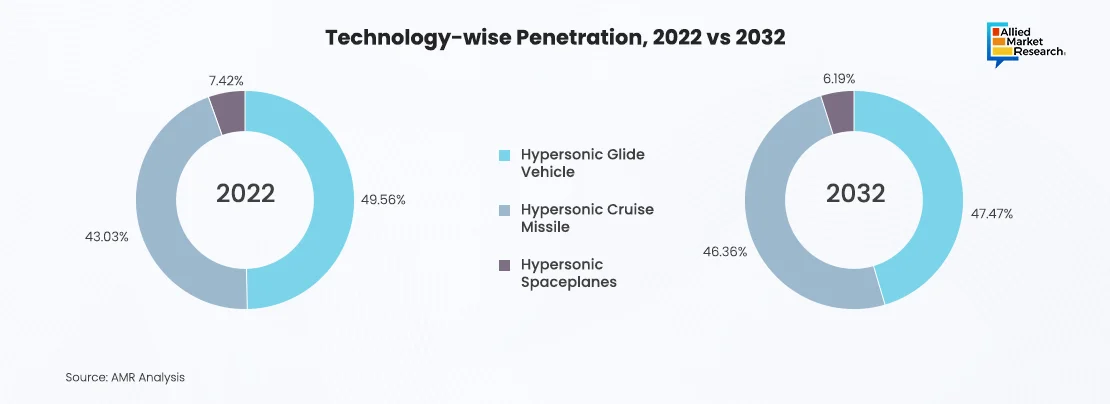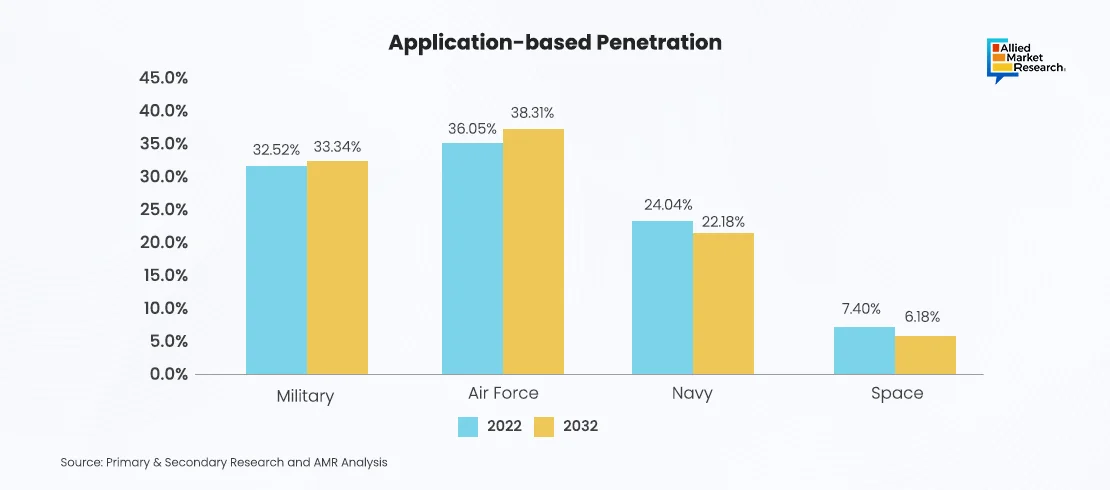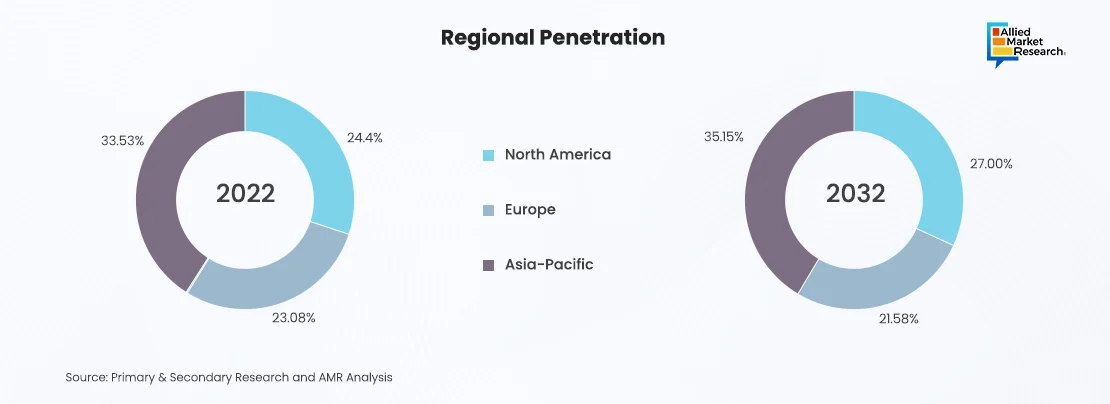Table Of Contents
- Principle of Hypersonic Technology
- Technology landscape
- Technology-wise Penetration, 2022 vs 2032
- Cutting EDGE Research & Development
- Propulsion Systems
- Materials and Structures
- Aerodynamics and Control
- Applications of Hypersonic Technology
- Civilian and Commercial Applications
- Application-based Penetration
- Difficulties & Concerns Faced
- Technical Challenges
- Regulatory and Environmental Concerns
- The Future Directions
- Regional Penetration

Lalit Janardhan Katare

Koyel Ghosh
Exploring the Supersonic Era: An In-Depth Discussion on Hypersonic Technology

In the era of aerospace engineering, the pursuit of faster, more efficient, and more capable flight has been a driving force since the inception of powered flight. From the Wright brothers' historic flight to the advent of supersonic aircraft like the Concorde, humanity has continually pushed the boundaries of what is possible in the skies above. In recent years, achieving hypersonic speeds has become the forefront of aviation and defense technology advancements. For instance, in February 2024, India based IIT Kanpur successfully established and tested India’s first Hypervelocity Expansion Tunnel Test Facility, S2.
The ground-breaking establishment and test have been acclaimed as a major step for India to further enhance its aerospace research and defense capabilities. Hypersonic technologies have become the new buzzwords in the strategic domain. Major powers like the US, Russia, and China are eagerly advancing their hypersonic weapon programs, while countries such as Iran and North Korea are also making strides in this area. Additionally, India is showing significant interest in developing hypersonic technologies. India’s hypersonic interest is in its infancy and will take some years to operationalize. However, the Hypervelocity Expansion Tunnel Test Facility have pointed to India’s continuous interest in the hypersonic sphere.
The above image represents the investments toward hypersonic technology to be implemented within these countries. This shows that the USA invests a major amount of their annual budget in the technological advancement field in order to obtain the latest technology in their ecosystem.

Principle of Hypersonic Technology
Since, hypersonic flight occurs at speeds exceeding Mach 5, or approximately 3,836 miles per hour (6,174 kilometers per hour), at these velocities, the aerodynamic and thermodynamic phenomena encountered by an aircraft or missile differ significantly from those experienced at subsonic or even supersonic speeds. Key characteristics of hypersonic flights include:
- High Temperatures: Friction with the air at hypersonic speeds generates extreme heat, requiring advanced materials and cooling techniques to protect the vehicle.
- Shock Waves: Intense shock waves form around the vehicle, affecting its stability and control.
- Reduced Air Density: The thinning air at high altitudes where hypersonic vehicles operate reduces aerodynamic lift, necessitating innovative design solutions.
- Plasma Formation: At extreme speeds, the air can ionize, creating a plasma sheath around the vehicle that affects communication and sensor performance.
Technology landscape
Hypersonic technology represents the forefront of aerospace engineering, offering revolutionary advancements in military capabilities, space exploration, and commercial aviation. Hypersonic vehicles, traveling at speeds exceeding Mach 5 (over 6,200 kilometers per hour), redefine global mobility and strategic defense, enabling rapid travel over vast distances. At the heart of hypersonic technology are propulsion systems designed to maintain flight at extraordinary speeds. Scramjets and dual-mode ramjet/scramjet engines leverage high-speed airflow to achieve sustained hypersonic flight, while ongoing research focuses on developing materials that can withstand the intense heat generated during flight. Recent developments have been carried out across the globe which has created ample opportunities for the growth of hypersonic technology.
For instance, as of May 2024, the U.S. has developed hypersonic technology enabling air travel at speeds ranging from Mach 6 to Mach 17, equivalent to over 4,600 to 13,000 miles per hour. This technology holds significant potential for both commercial aviation and space travel applications. Control and guidance systems play a crucial role in maintaining stability and maneuverability amidst extreme aerodynamic forces. Advanced aerodynamic designs and thermal management systems minimize drag and manage heat, ensuring optimal performance and structural integrity. In military applications, hypersonic technology offers unparalleled speed and precision in delivering conventional or nuclear payloads, challenging existing air defense systems and enhancing deterrence capabilities against emerging threats. In space exploration, hypersonic air-breathing engines pave the way for reusable launch vehicles, promising more cost-effective access to space. Hypersonic atmospheric entry vehicles allow for quicker, more efficient reentry, enabling rapid return from orbit.
Commercially, hypersonic travel sparks renewed interest in supersonic passenger aircraft, aiming to cross oceans in mere hours. Overcoming previous hurdles such as sonic booms and fuel efficiency concerns, hypersonic technology offers quieter, more fuel-efficient propulsion systems with reduced environmental impact. Ongoing research aims to improve engines, materials, and rules to make sure flying cars are safe and work well with current systems, but there are still big challenges to tackle. Furthermore, hypersonic technology is a major advancement in aerospace engineering that will greatly impact military, space exploration, and commercial aviation. Despite obstacles, ongoing efforts aim to fully utilize hypersonic flight, bringing about a new era of global travel and strategic advancement.
Technology-wise Penetration, 2022 vs 2032
The image depicts the technological adoption of hypersonic technology in 2022 and forecasts its penetration by 2032. Leading companies have invested heavily in hypersonic glide vehicles, indicating a strong preference for 2022. However, there's a growing trend among countries toward developing hypersonic cruise missiles, suggesting a forthcoming global surge in this technology.

Cutting EDGE Research & Development
Several countries and organizations are at the forefront of hypersonic technology development, including the United States, Russia, China, and private companies like SpaceX and Boeing. Each is pursuing various approaches to achieve reliable and sustainable hypersonic flight.
Propulsion Systems
Hypersonic vehicles require advanced propulsion systems to achieve and maintain their incredible speeds. The primary propulsion technologies include:
- Scramjets (Supersonic Combustion Ramjets): Scramjets operate by compressing incoming air at high speeds, mixing it with onboard fuel, and igniting the mixture. Unlike traditional jet engines, scramjets have no moving parts, making them simpler and potentially more reliable at hypersonic speeds.
- Rocket Engines: Rockets provide the high thrust needed to reach hypersonic speeds quickly but are less efficient for sustained flight within the atmosphere.
- Combined-Cycle Engines: These systems combine elements of turbojet, ramjet, and scramjet technologies, enabling efficient operation across a wide range of speeds.
Materials and Structures
Developing materials that can withstand the extreme conditions of hypersonic flight is a significant challenge. Researchers are exploring:
- Thermal Protection Systems (TPS): These include ablative materials that absorb heat through chemical reactions and reusable ceramic composites that insulate and protect the vehicle's structure.
- High-Temperature Alloys and Composites: Materials like titanium alloys, carbon-carbon composites, and ultra-high-temperature ceramics (UHTCs) are being investigated for their ability to maintain strength and integrity at high temperatures.
Aerodynamics and Control
Hypersonic aerodynamics is a complex field requiring advanced computational models and wind tunnel testing. Researchers focus on:
- Shape Optimization: Designing shapes that minimize drag and heat while maximizing stability and control.
- Active Cooling: Integrating cooling systems that circulate fluids through the vehicle's structure to dissipate heat.
- Plasma Interactions: Studying the effects of plasma on communication systems and developing methods to mitigate signal loss.
Applications of Hypersonic Technology
- Defense Usage: Hypersonic technology offers significant strategic defense advantages, driving substantial investments from major global powers.
- Hypersonic Missiles: These weapons can strike targets with unprecedented speed and precision, making them difficult to intercept with current defense systems. This includes some of the available models such as the Russian Avangard and the Chinese DF-ZF which are actively using the hypersonic technology.
- Rapid Global Strike Capabilities: Hypersonic vehicles could enable rapid deployment of military assets anywhere in the world, enhancing response times and strategic flexibility.
- Intelligence, Surveillance, and Reconnaissance (ISR): Hypersonic drones, on the other hand, could provide real-time data from high-altitude and high-speed operations, improving situational awareness.
Civilian and Commercial Applications
While military applications currently dominate hypersonic research, civilian uses hold transformative potential.
- Commercial Air Travel: Hypersonic passenger aircraft could drastically reduce travel times, making transcontinental flights a matter of hours rather than days. Companies like Boeing and Lockheed Martin are exploring concepts for hypersonic airliners.
- Space Access: Hypersonic technology can lower the cost and increase the efficiency of space travel. Vehicles like SpaceX's Starship, designed for both orbital and point-to-point travel, could benefit from hypersonic advancements.
- Scientific Research: Hypersonic platforms could facilitate high-speed atmospheric research, improving our understanding of aerodynamics, material science, and climate dynamics.
Application-based Penetration
The above illustration projects the application-based penetration of hypersonic technology into numerous end use industries. This includes military, air force, navy and space across which the penetration has been depicted. The dominance of the air force and military sectors in the industry is attributed to the significant advancements in hypersonic technology implementation.
Difficulties & Concerns Faced
Technical Challenges
Achieving reliable and sustainable hypersonic flight involves overcoming several technical hurdles:

- Thermal Management: Developing materials and systems to withstand extreme heat remains a critical challenge. Future research aims to improve the durability and efficiency of thermal protection systems.
- Propulsion Efficiency: Enhancing the efficiency and reliability of scramjets and other propulsion systems is vital for practical hypersonic travel.
- Control and Stability: Ensuring vehicle stability and control at hypersonic speeds requires sophisticated guidance systems and real-time adjustments.
Regulatory and Environmental Concerns
- Safety Standards: Establishing rigorous safety standards for hypersonic vehicles is also essential to protect passengers and operators.
- Environmental Impact: The environmental implications of hypersonic travel, particularly its potential effects on the upper atmosphere, need thorough investigation.
- International Regulations: Coordinating international regulations and agreements is again important to manage the deployment and use of hypersonic technology responsibly.
The Future Directions
The future of hypersonic technology is expected to revolutionize military, aerospace, and commercial sectors globally. Militarily, hypersonic missiles will enhance strategic deterrence. In aerospace, hypersonic vehicles will enable faster space access, benefiting satellite deployment and space exploration. Commercially, hypersonic passenger aircraft promise significantly reduced intercontinental travel times. However, challenges like material durability, high costs, and advanced infrastructure are hurdles indeed. Geopolitically, the technology might increase tensions and require new arms control agreements, while also offering opportunities for international collaboration in non-military applications.
Regional Penetration
The above image portrays the future growth prospects of hypersonic technology across different regions such as North America, Europe & Asia-Pacific. This represents Asia-Pacific being the leader in the adoption of hypersonic & advanced technologies across different industries due to the ongoing race between Asian countries to lead the race. Furthermore, the developments in these areas have expanded the potential for the technology's growth. This includes some of the developments such as:

- China leads the world in developing, testing and deploying hypersonic weapons, beating out Russia while the U.S., having already spent $12 billion, has yet to deploy a model. The weapons can travel five times the speed of sound, making it extremely difficult for existing defensive systems to intercept them. Similarly, the U.S. Air Force has successfully tested an air-launched hypersonic weapon in the Pacific Ocean. The test, conducted in March 2024, involved a B-52 bomber departing from Guam carrying an Air-launched Rapid Response Weapon (ARRW).
- In March 2024, Pentagon (U.S.) partnered with Japan to develop Hypersonic technology.
- In January 2024, Iran and North Korea claimed to successfully test the hypersonic missile technology. This launch represents the convergence of two recent milestones for Pyongyang’s weapons development program: solid-fuel missiles and missiles featuring a “maneuvering re-entry vehicle.”
Hypersonic technology showcases humanity's relentless drive for advancement in aerospace engineering, offering a promising vision for the future of both military and civilian transportation. Its development represents a major shift in our understanding of flight, with the potential for unmatched speeds and efficiency. This upcoming supersonic era promises to revolutionize travel, making it faster, smoother, and more expansive, and reshaping the sky.
Allied Market Research delves into the intricacies of hypersonic technologies and other related products, as we aim to provide vendors with comprehensive insights into the evolving landscape. We provide in-depth details through highly curated reports that portray technological advancements, market trends, and government initiatives concerning the domain, which in turn help businesses integrate hypersonic technology into their operations. To get more insights into the aerospace & defense domain, contact our specialists today!

